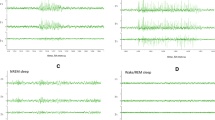WAG-Rij rats are a model of genetic absence epilepsy, characterized by the presence of peak-wave discharges (PWD) on the EEG. The first PWD in WAG-Rij rats are known to occur at age 2–3 months, the number and duration then increasing. However, the evolution of PWD during the progressive development of absence epilepsy in WAG-Rij rats remains uninvestigated. The aim of the present work was to identify developmental changes in the time-frequency dynamics, frequency spectrum, and morphological features of PWD in WAG-Rij rats. The evolution of PWD was studied in individual rats from age two months to age 12 months. PWD were found to form at age 2–4 months, after which morphological changes in PWD were seen. During the progressive development of absence epilepsy, PWD displayed three stages of “maturation.” It is suggested that the age-related evolution of PWD in rats may reflect progressive electrophysiological changes in the somatosensory cortex – a brain area linked with the generation and generalization of PWD.
Similar content being viewed by others
References
E. Yu. Sitnikova, V. V. Gruboe, A. E. Khramov, and A. A. Koronovskii, “Developmental changes in the time-frequency structure of sleep spindles on the EEG in rats with genetic predisposition to absence epilepsy (WAG-Rij rats),” Zh. Vyssh. Nerv. Deyat., 62, No. 6, 733–744 (2012).
Bosnyakova D, A. Gabova, G. Kuznetsova, et al., “Time-frequency analysis of spike-wave discharges using a modified wavelet transform,” J. Neurosci. Meth., 30, No. 154, 80–88 (2006).
D. Bosnyakova, A. Gabova, A. Zharikova, et al., “Some peculiarities of time-frequency dynamics of spike-wave discharges in humans and rats,” Clin. Neurophysiol., 118, No. 8, 1736–1743 (2007).
A. Coenen, and E. van Luijtelaar, “Genetic animal models for absence epilepsy: a review of the WAG/Rij strain of Rats,” Behav. Genetics, 33, No. 6, 635–655 (2003).
A. Destexhe and T. Sejnowski, Thalamocortical Assemblies. How Ion Channels, Single Neurons and Large-Scale Networks Organize Sleep Oscillations, Oxford Univ. Press, Oxford (2001).
D. Ellens, Hong E, K. Giblin, et al., “Development of spike-wave seizures in C3H/HeJ mice,” Epilepsy Res., 85, No. 2, 53–59 (2009).
M. Islam, and J. Abdullah, “Age-dependent electroencephalographic differences in the Genetic Absence Epilepsy Rats from Strasbourg (GAERS) model of absence epilepsy,” Malays. J. Med. Sci., Spec. Iss. 34–40 (2014).
G. Jarre, T. Altwegg-Boussac, M. Williams, et al., “Building up absence seizures in the Somatosensory cortex: from network to cellular epileptogenic processes,” Cereb. Cortex, 27, No. 9, 4607–4623 (2017).
G. Kostopoulos, “Spike-and-wave discharges of absence seizures as a transformation of sleep spindles: the continuing development of a hypothesis,” Clin. Neurophysiol., 111, No. 9, 27–38 (2000).
J. P. Manning, D. A. Richards, N. Leresche, et al., “Cortical-area specific block of genetically determined absence seizures by ethosuximide,” Neuroscience, 123, No. 1, 5–9 (2004).
H. K. Meeren, J. P. Pijn, E. L. van Luijtelaar, et al., “Cortical focus drives widespread corticothalamic networks during spontaneous absence seizures in rats,” J. Neurosci., 22, No. 4, 1480–1495 (2002).
H. Meeren, G. van Luijtelaar, F. Lopes da Silva, and A. Coenen, “Evolving concepts on the pathophysiology of absence seizures: the cortical focus theory,” Arch. Neurol., 62, No. 3, 371–376 (2005).
P. O. Polack, I. E. Guillemain, C. Deransart, et al., “Deep layer somatosensory cortical neurons initiate spike-and-wave discharges in a genetic model of absence seizures,” J. Neurosci., 27, No. 24, 6590–6599 (2007).
P. O. Polack, S. Mahon, M. Chavez, and S. Charpier, “Inactivation of the somatosensoty cortex prevents paroxysmal oscillations in cortical and related thalamic neurons in a genetic model of absence epilepsy,” Cereb. Cortex, 19, No. 9, 2078–2091 (2009).
K. Y. Sarkisova and A. V. Gabova, “Maternal care exerts disease-modifying effects on genetic absence epilepsy and comorbid depression,” Genes Brain Behav. (2018); 2018 DOI: https://doi.org/10.1111/gbb.12477.
K. Yu. Sarkisova, A. V. Gabova, M. A. Kulikov, et al., “Rearing by foster Wistar mother with high level of maternal care counteracts the development of genetic absence epilepsy and comorbid depression in WAG/Rij rats,” Dokl. Biol. Nauk, 473, No. 2, 246–249 (2017).
K. Sarkisova and G. van Luijtelaar, “The WAG/Rij strain: a genetic animal model of absence epilepsy with comorbidity of depression,” Prog. Neuropsychopharmacol. Biol. Psychiatry, 35, No. 4, 854–876 (2011).
E. Sitnikova and G. van Luijtelaar, “Electroencephalographic characterization of spike-wave discharges in cortex and thalamus in WAG/Rij rats,” Epilepsia, 48, No. 12, 2296–2311 (2007).
E. van Luijtelaar and A. Coenen, “Spontaneous occurrence of spike-wave discharges in five inbred strains of rats,” Physiol. Behav., 48, No. 1, 199–201 (1990).
M. Vergnes, C. Marescaux, A. Depaulis, et al., “Ontogeny of spontaneous petit mal-like seizures in Wistar rats,” Brain Res., 395, 85–87 (1986).
M. von Krosigk, T. Bal, and D. McCormick, “Cellular mechanisms of a synchronized oscillation in the thalamus,” Science, 261, 361–364 (1993).
Author information
Authors and Affiliations
Corresponding author
Additional information
Translated from Rossiiskii Fiziologicheskii Zhurnal imeni I. M. Sechenova, Vol. 104, No. 10, pp. 1176–1189, October, 2018.
Rights and permissions
About this article
Cite this article
Gabova, A.V., Sarkisova, K.Y., Fedosova, E.A. et al. Developmental Changes in Peak-Wave Discharges in WAG/Rij Rats with Genetic Absence Epilepsy. Neurosci Behav Physi 50, 245–252 (2020). https://doi.org/10.1007/s11055-019-00893-y
Received:
Revised:
Published:
Issue Date:
DOI: https://doi.org/10.1007/s11055-019-00893-y




